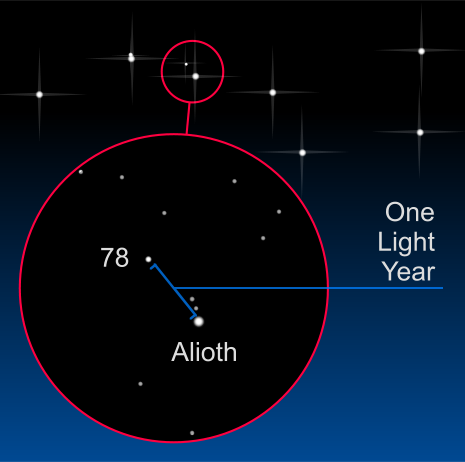|
A unit of interstellar distance, defined as the distance light travels in a period of one year. The speed of light is constant, at about 300,000 km per second: a light year is very nearly 10 million million km. From an Earthbound perspective, this is a vast distance - our entire Solar System, out to the orbit of Pluto, is only one eight-hundredth of a light year across.
On an interstellar scale, though, a single light year is rather small. It covers less than a quarter of the distance to our nearest neighbour, Proxima Centauri. Our entire Galaxy is a little over 100,000 light years across or more.
Because a light year is directly related to the time light takes to travel through space, it follows that we look out into the universe we also look back in time. For example, in about the year 5,250 BCE, a star in the constellation of Taurus exploded. That star was about 6,300 light years from Earth, meaning that the light from the explosion took 6,300 years to cross the intervening space, and finally reached us in the year 1054 CE; that was the date that Earth-bound observers finally saw the event that created the Crab Nebula. This 'lag' is a consequence of the immense distances between the stars - when we look up at the Crab Nebula today, we see it not as it is now, but as it was in about 4,300 BCE.


Meet the neighbours. This chart shows all the stars and other significant objects within twenty light years of the Sun. This map is organised by galactic longitude, so it is arranged as if looking 'down' through the Galactic disc, and objects near the top of the chart lie in the direction of the Galactic nucleus. The diameter of each object shown represents its intrinsic luminosity.
Perhaps because of this, the term 'light year' is sometimes misused as a unit of time (in expressions like 'light years ago' or 'light years into the future'). This is never correct - a 'light year' is only ever used to measure distance.

Seeing a Light Year: Alioth, the third star in the handle of the Plough or Big Dipper, has a tiny faint neighbour, 78 Ursae Majoris. These two stars are almost exactly the same distance from Earth (about 81 light years), and the angle between them describes a distance close to one light year.
In actual practice, astronomers more usually prefer the parsec, a unit equivalent to about 3¼ light years, rather than the light year itself. Nevertheless, the light year remains a useful conceptual unit. The term is sometimes rendered 'light-year' or 'lightyear', and often abbreviated to 'ly' or 'l.y.'.
The light year has various derivative units, of which only three are come across with any frequency:
| Unit | Equivalent distance |
| Kilo-light year |
1,000 ly |
| Light Minute |
17,987,547 km |
| Light Second |
299,792 km |
Others can be invented for specific uses, like the 'nano-light year' (94,605 km) or the 'light millennium' (a picturesque term for 1,000 light years), but these are almost never encountered in practice. The smallest such unit possible would be the 'atto-light year', which would be just under one centimetre in length!
|
|